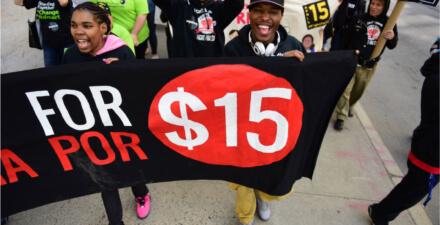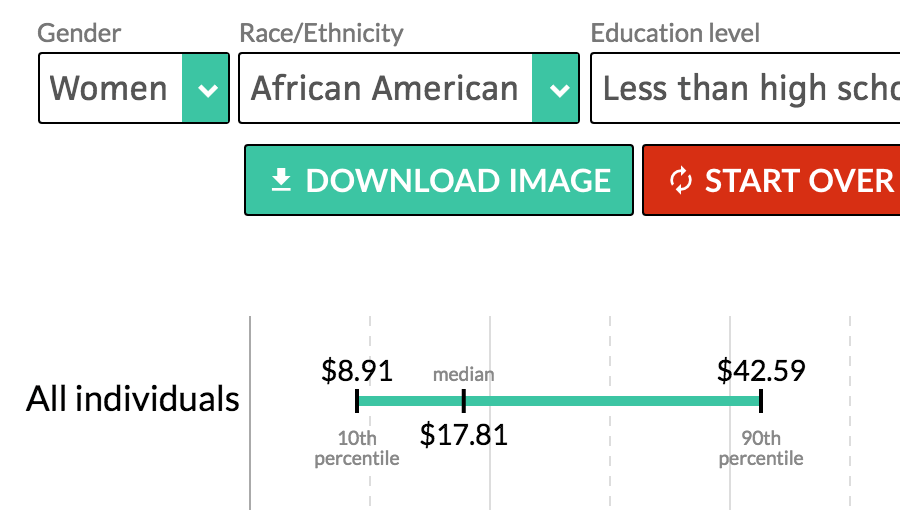Brad DeLong: Worthy reads on equitable growth, September 28–October 4, 2019
Worthy reads from Equitable Growth:
- Listen to Kate Bahn’s podcast, “Real talk with feminist visionaries, Season 3, No. 23, Kate Bahn.” This isn’t your Econ 101 take on the economy!
- Read Equitable Growth grantee Ellora Derenoncourt’s new paper with co-author Claire Montialoux, “Minimum Wages and Racial Inequality,” in which they present a key finding: “20 percent of the decline in the racial earnings gap during Civil Rights era stemmed from one single reform of the minimum wage.”
- Read Jonathan Sallet, “Competitive Edge: Five Building Blocks for Antitrust Success: The Forthcoming FTC Competition Report,” in which he writes: “Here are five building blocks for successful antitrust enforcement that the Federal Trade Commission should embrace in order to, as its Chairman Joseph Simons said (quoting his predecessor Bob Pitofsky), ‘restore the tradition of linking law enforcement with a continuing review of economic conditions to ensure that the laws make sense in light of contemporary competitive conditions’ … Pay attention to growing market concentration … Business models are evolving [and] today, multisided business models intersect with other economic trends that include network effects, the aggregation of data, and vertical integration … Antitrust enforcement protects competition, not just consumers … Modern economic analysis is up to the challenge … Congress gave the FTC broader enforcement tools than just the Sherman and Clayton Acts.”
- Re-read Carmen Ye, “Why we need better re-employment policies for formerly incarcerated African American men,” because she makes these important points: “African American men … 33 percent of the 1.56 million Americans held in state or federal prisons … When these men are released from prison, what will their employment prospects look like? … Black applicants with no criminal record receive a callback or job offer at the same rate as white applicants with a felony conviction. Yet black applicants without a criminal record were three times as likely to get a callback as those with a record.”
Worthy reads not from Equitable Growth:
- Once again, we have a piece by an impressively credentialed academic Republican economist that seems to me to have no contact with reality. There is no economist I know of, save for Robert Barro, who has ever said or implied that the “neutral” real interest rate today is the same 2.4 percent that the average real interest rate was from 1986–2008. To the contrary, there has been a very long and active discussion—led over the past two decades by current New York Fed President John Williams—about how far the “neutral” rate has fallen and how persistent that fall will be. And one conclusion of that debate has been that the current real federal funds rate of “only 0.7 percent” does indeed look “high” by some important metrics. So, why would anyone write as though this literature does not exist? Read Robert J. Barro, “Is Politics Getting to the Fed?,” in which he writes: “From the early 1980s until the start of the financial crisis in September 2008, the U.S. Federal Reserve seemed to have a coherent process for adjusting its main short-term interest rate, the federal funds rate. Its policy had three key components: the nominal interest rate would rise by more than the rate of inflation; it would increase in response to a strengthening of the real economy; and it would tend toward a long-term normal value. Accordingly, one could infer the normal rate from the average federal funds rate over time. Between January 1986 and August 2008, it was 4.9 percent, and the average inflation rate was 2.5 percent … The Fed’s prolonged low-interest-rate policy, which was supplemented by quantitative easing [or QE], seems misguided, considering that the economy had long since recovered, at least in terms of the unemployment rate. The nominal federal funds rate was not placed on an upward trajectory until the end of 2016 … It is hard to view today’s nominal federal funds rate of 2.4 percent as high. With an inflation rate of 1.7 percent, the real federal funds rate is only 0.7 percent. And yet the Fed’s “high”-interest-rate policy was fiercely attacked by Wall Street … That view is not crazy if you are focused solely on boosting the stock market. On average, interest-rate cuts do tend to stimulate the stock market by making real returns on bonds less competitive. But that does not mean it is good economic policy always to be cutting rates.”
- A very nice look back at a big story from a decade ago that simply did not happen. Read Ben Casselman, “The White-Collar Job Apocalypse That Didn’t Happen,” in which he writes: “‘Where in retrospect I missed the boat is in thinking that the gigantic gap in labor costs between here and India would push it to India rather than to South Dakota,’ Mr. Blinder said in a recent interview … Adam Ozimek revisited Mr. Blinder’s analysis to see what had happened over the past decade. Some job categories that Mr. Blinder identified as vulnerable, like data-entry workers, have seen a decline in United States employment. But the ranks of others, like actuaries, have continued to grow … Overall, of the 26 occupations that Mr. Blinder identified as ‘highly offshorable’ and for which Mr. Ozimek had data, 15 have added jobs over the past decade and 11 have cut them. Altogether, those occupations have eliminated fewer than 200,000 jobs over 10 years, hardly the millions that many feared … In the jobs that Mr. Blinder identified as easily offshored, a growing share of workers were now working from home. Mr. Ozimek said he suspected that many more were working in satellite offices or for outside contractors, rather than at a company’s main location. In other words, technology like cloud computing and videoconferencing has enabled these jobs to be done remotely, just not quite as remotely as Mr. Blinder and many others assumed … Call centers [and] telemarketing jobs have declined sharply in the United States since 2007, as much of the work was sent overseas. But the number of customer service representatives has continued to grow … Telemarketers are essentially selling products and often working from a script. Customer service and other call-center work like tech support often require a more nuanced understanding of the customer experience.”
- There are remarkably good odds that the next global recession will be triggered by the miscalculations of politicians who have no business holding any office whatsoever. I have but one quibble with Nouriel Roubini’s argument here. The situation in Argentina is dire for Argentina and the southern cone, but it is not the kind of thing that can provoke a global recession. President Donald Trump and UK Prime Minister Boris Johnson, by contrast, might. Read Nouriel Roubini, “Four Collision Courses for the Global Economy,” in which he writes: “Between U.S. President Donald Trump’s zero-sum disputes with China and Iran, U.K. Prime Minister Boris Johnson’s brinkmanship with Parliament and the European Union, and Argentina’s likely return to Peronist populism, the fate of the global economy is balancing on a knife edge. Any of these scenarios could lead to a crisis with rapid spillover effects … In each case, failure to compromise would lead to a collision, most likely followed by a global recession and financial crisis … The problem is that while compromise requires both parties to de-escalate, the tactical logic of chicken rewards crazy behavior. If I can make it look like I have removed my steering wheel, the other side will have no choice but to swerve. But if both sides throw out their steering wheels, a collision becomes unavoidable.”
- No matter what our domestic economic problems, it is still essential to remind ourselves that for humanity as a whole, the years since 1980 have seen the greatest improvement in economic well-being, globally, of any 40-year period in human history. We have been truly blessed. Read Noah Smith, “Globalization Has Cut Inequality Between Rich and Poor Countries,” in which he writes: “Up through the 1980s, the blessings of the Industrial Revolution seemed largely confined to a handful of countries in Western Europe, East Asia, the [United States], Australia, and Canada. But in the past three decades, there has been a sea change, and developing countries have made great strides in catching up. Although inequality has risen within some nations, at the global level it’s going down: Much of this catch-up is happening in countries that are still largely poor, such as India or Indonesia. To an economist—or someone who cares about alleviating the suffering of the world’s poorest people—this still represents a miracle. But a skeptic of globalization might wonder whether it can really be called a success if broad middle-class living standards still remain the exclusive privilege of a handful of nations, many of them former colonial powers.”







